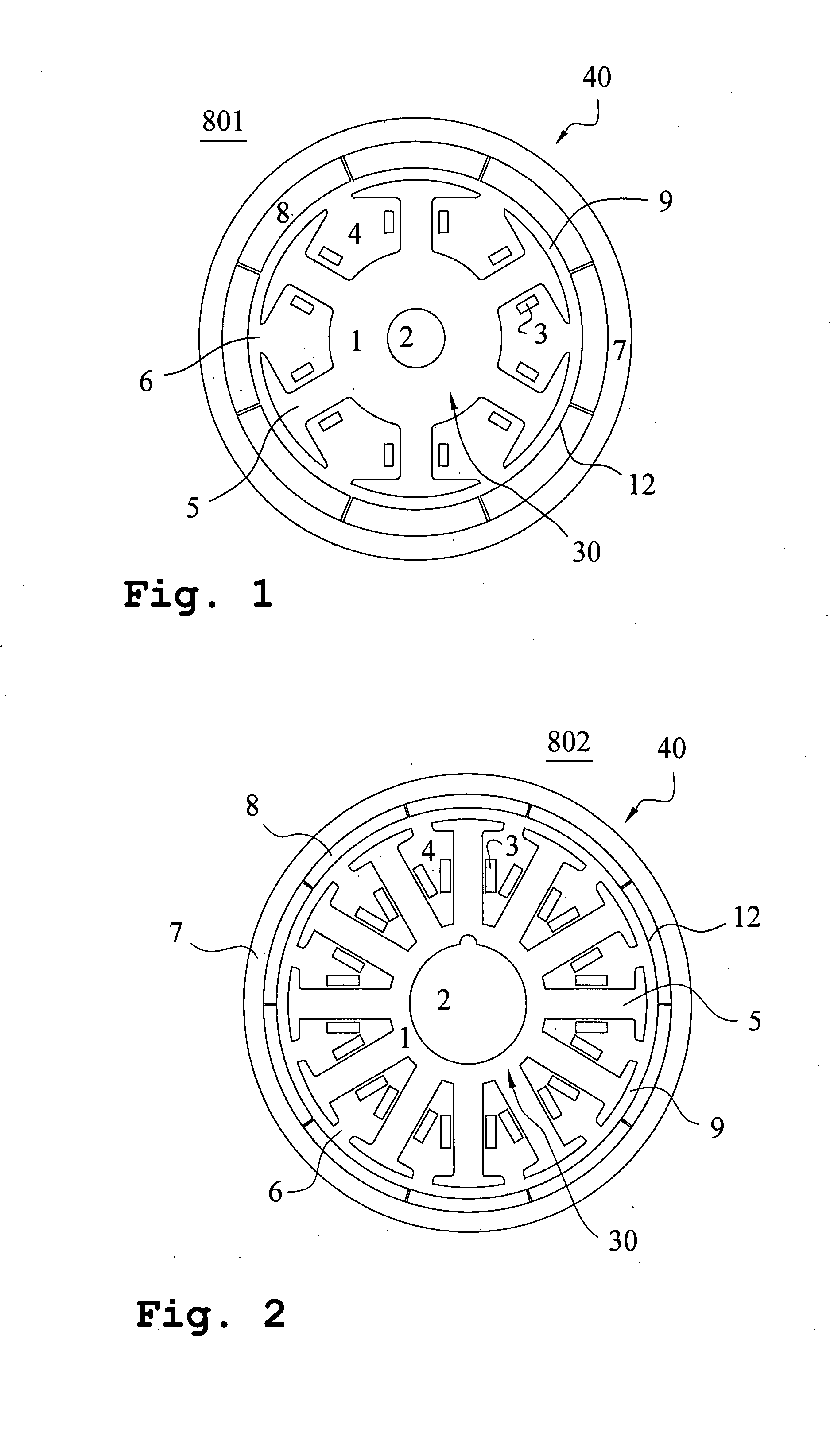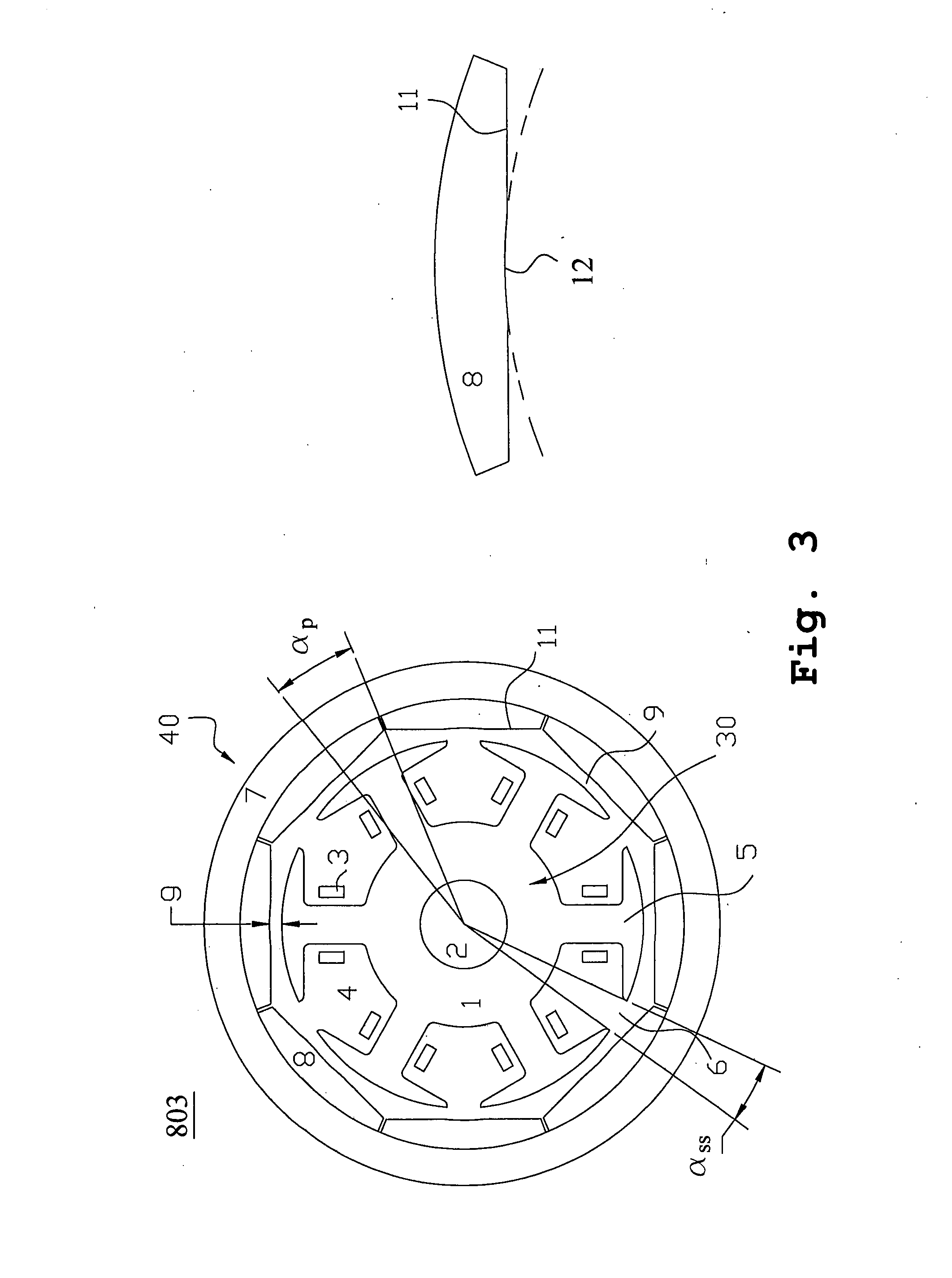Permanent magnet rotary structure of electric machine
- Summary
- Abstract
- Description
- Claims
- Application Information
AI Technical Summary
Benefits of technology
Problems solved by technology
Method used
Image
Examples
first embodiment
[0063]Subsequently, a preferred embodiment of the present invention is presented as follows to demonstrate the preceding principle. Please refer to FIG. 6, which is a cross-sectional view illustrating the first embodiment regarding the rotary structure of a permanent magnet motor for the present application. The rotary structure 806 of the permanent magnet motor in FIG. 6 is based on the outer rotor permanent magnet motor illustrating in FIG. 1 but the structure for decreasing the cogging torque is further incorporated thereinto. The rotary structure 806 is a permanent magnet motor with eight poles and six slots, but it is not limited to the permanent magnet motor, and the same structure is also applicable to the permanent magnet generator. In FIG. 6, the rotary structure 806 of the permanent magnet motor includes a stator 30 and a rotor 40, in which the cylindrical stator 30 is fixed inside the inner space of permanent magnet motor in order to produce a rotating magnetic field. The...
second embodiment
[0067]Furthermore, a permanent magnet motor with ten poles and twelve slots is presented as an example for addressing the reduction of the cogging torque. Please refer to FIG. 7, which is a cross-sectional view illustrating the second embodiment regarding the rotary structure of a permanent magnet motor for the present application. The rotary structure 807 of the permanent magnet motor in FIG. 7 is based on the outer rotor permanent magnet motor illustrating in FIG. 2 but the structure for decreasing the cogging torque is further incorporated thereinto. Both FIGS. 2 and 7 share the same reference numerals for addressing the identical element. In order to reduce the cogging torque, at least one groove 10 is disposed at the arc surface 12 along the circumference direction of each permanent magnet 8 in FIG. 7. The structure demonstrated in this preferred embodiment is defined as follows: follows: P=5, K=12, M=60 and f=60. After calculating, it is understood that the preferred angular p...
third embodiment
[0083]Subsequently, a preferred embodiment of the present invention is presented as follows to demonstrate the preceding principle. Please refer to FIG. 8, which is a cross-sectional view illustrating the third embodiment regarding the rotary structure of a permanent magnet motor for the present application. The rotary structure 808 of the permanent magnet motor in FIG. 8 is based on the outer rotor permanent magnet motor illustrating in FIG. 3 but the structure for reducing the cogging torque is further incorporated thereinto. Both figures share the same reference numerals for addressing the identical element. In the present preferred embodiment, the relevant computing parameters are defined as follows: P=4, K=6, M=24 and f=24. In accordance with step (q), calculating and choosing an angle, αp, along the circumference direction within an angular range for each angular range corresponding to the pair of the arc-cut surface 11 of the permanent magnets 8. The phase difference, α0, bet...
PUM
 Login to View More
Login to View More Abstract
Description
Claims
Application Information
 Login to View More
Login to View More - R&D
- Intellectual Property
- Life Sciences
- Materials
- Tech Scout
- Unparalleled Data Quality
- Higher Quality Content
- 60% Fewer Hallucinations
Browse by: Latest US Patents, China's latest patents, Technical Efficacy Thesaurus, Application Domain, Technology Topic, Popular Technical Reports.
© 2025 PatSnap. All rights reserved.Legal|Privacy policy|Modern Slavery Act Transparency Statement|Sitemap|About US| Contact US: help@patsnap.com



